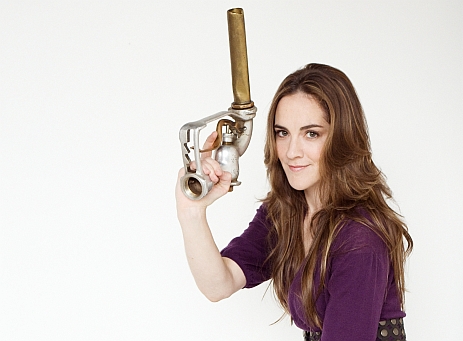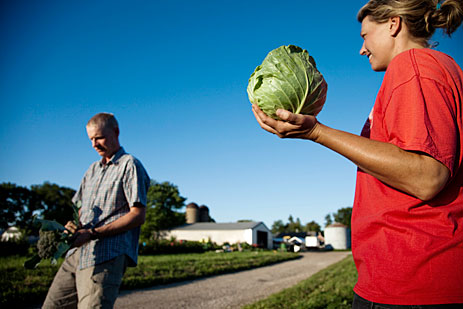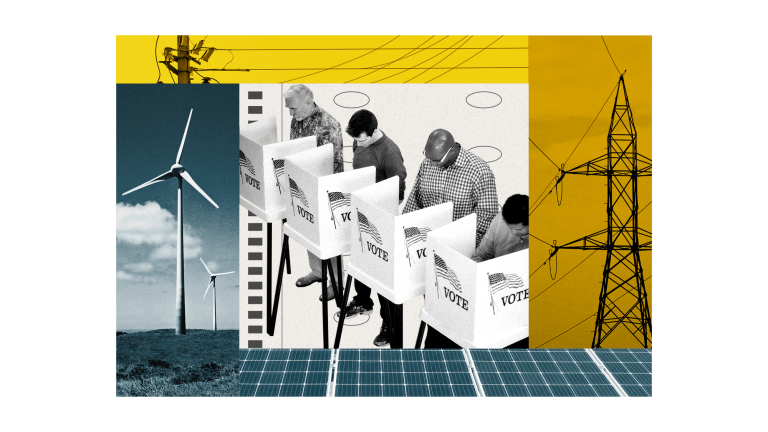 Matt and Peg Sheaffer run Sandhill Organics in Prairie Crossing.(Michael Hanson)
Matt and Peg Sheaffer run Sandhill Organics in Prairie Crossing.(Michael Hanson)
For the final stop on the Breaking Through Concrete tour, we’re gettin’ all peri-urban on y’all.
It takes almost an hour to drive from downtown Chicago north on I-94 to the town of Grayslake, Ill., home of the Prairie Crossing residential development — “A Conservation Community” — and its core farm, Sandhill Organics. Though billboards, office “parks,” and standard Interstate culture dot the highway, the tall, mixed prairie grasses native to these Great Lake Plains become increasingly expansive.
The approach from the interstate to Prairie Crossing tells a modern American story. A natural lake with tree snags, lily pads, and marsh grasses covers a depression between a rim of trees and wild, hip-high grasses. A mile down the road, a fresh slab of pavement holds a large parking lot and a shopping center with chain stores. Then more open land, some large cornfields, and a walled development of cookie-cutter homes with multiple pitched roofs, elaborate garages, and lots of short, non-native grass to mow.
If you’ve been following this series, you’re surely familiar with the lament over lost farmland replaced by shoddily designed and developed, uniformly average orgies of square-footage known as the modern American house. It sounds elitist — probably is — but it’s true and, unfortunately, it’s happening and it will continue happening for a while, at least, because the American dream for many people remains cars that get driven all day, double-vaulted ceilings in the foyer, your own lawn to mow, and safety in homogeny.
As long as we’re critiquing, Prairie Crossing has its place in this suburbanization of the rural world. It is a planned community of large homes that only a certain economic strata can afford, and it plowed over some prairie land to make it happen.
But now the good part.
Prairie Crossing was developed to conserve prairie, and it’s not just a marketing slogan. Vicky and George Ranney, the developers, set aside 60 percent of the 677 acres in a land conservation easement; another 3,200 acres are protected within the Liberty Prairie Reserve, a conglomeration of public and private land connected to the community.
From the beginning, the Ranneys believed in agriculture as an essential component, so they established 100 acres strictly for growing food. “This land was always farmland,” says Vicky. “So we considered what people would like to live next to. We realized that sooner or later, there’d be a conflict between big agriculture and residential developments. People wouldn’t find it comfortable to live next to pesticides and chemicals.”
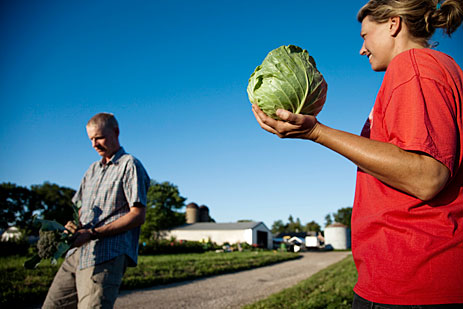
(Michael Hanson)
The Sheaffers are entrepreneurs as much as they are farmers.The mixture worked. They sold all the homes (about 400), and at a rate 34 percent above the market for the similarly sized developments and homes in the area. The farm is one of Prairie Crossing’s many differentiating factors — native grasses encouraged to grow wild in front yards, a charter school with an experiential curriculum located on-site and open to the entire county, geothermal heating, open land, trails, a swimming lake, and a light-rail city connection make good selling points as well. It also has large-scale, intensive, integrated produce and livestock farm that marks a huge leap for peri-urban growth. Just a few years ago, even the most progressive projects looked at small “playscapes” or raised-bed community garden plots as radical green space. A hundred acres of organic, production farmland distinguishes Prairie Crossing and gives it a place in the urban farm puzzle — albeit as a variation.
Prairie Crossing is one of the earliest examples of what architect and planner Andrés Duany calls “Agricultural Urbanism.” Duany, along with others, has created a movement in the planning, developing, and architectural world with his New Urbanism model for sustainable design on a wildly big-picture level. New Urbanism wants to create a new language for coding and zoning and design practices, so that the builders of communities, cities, even regions can look more like traditional communities that were less about the automobile and more about living smaller, more densely, more neighborly, and with less societal and environmental impact.
A new chapter in the discussion is this idea of Agricultural Urbanism. Duany differentiates agricultural urbanism from urban agriculture in simple terms: agricultural urbanism creates the walkable urban form surrounded by agriculture, whereas urban agriculture is simply growing food on vacant lots and in backyards. He cites Detroit as a hub of urban agriculture but not Agricultural Urbanism, but he’d call Prairie Crossing the latter.
Peg and Matt Sheaffer grow most of the food. They came into Prairie Crossing early, as the original farmers for Sandhill Organics. The Ranneys offered to lease them 45 acres of certified organic farmland. The Sheaffers moved into the farmhouse and they’ve made it a thriving business, thanks to CSA membership and Chicago farmers market sales. They make a lot more money per acre — roughly $20,000 per acre — than the mono-crop farmers who dominate the rest of Illinois, who average roughly $800 per acre.
The Sheaffers want other Prairie Crossing residents to consider them their neighbors and friends first, the community farmers second.There’s an additional 50 acres of farmland at Prairie Crossing, some of which is used by the Learning Farm project for youth programs, from elementary students to a diverse corps of high schoolers from all over the county who work under the guidance of staff and a few college interns. And in the “back 40” of the property, four “incubator farms” grow produce and raise pigs and chickens. Part of the Farm Business Development Center, these young farmers get the chance to take a stab at creating a viable, profitable farm business. When they’re ready, they leave to create their own independent farms.
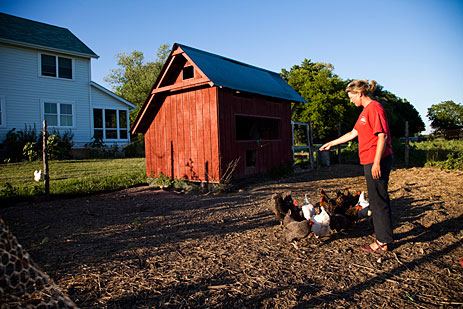
Prairie Crossing is a farm that grows farms and farmers.
So how does this work? And why doesn’t it happen more often?
Mike Sands, executive director for the Liberty Prairie Foundation, has some insight. He was previously the managing director of the Rodale Institute, a 63-year-old organization dedicated to organic agriculture research and education.
“True urban farms are incredibly important,” says Mike. “But if you consider food productivity potential, they’re limited. I do think we’re ready for that next generation of urban farming — using waste heat to power year-round production. The urban farm can provide supplemental production, but its real value is as an entry point to food quality and why that matters. And it improves its immediate community — aesthetically and psychologically.
The challenge presented by Sandhill Organics, he says, is not only the diverse, integrated growing, but the marketing and financial planning involved: “We don’t have those farmers. If you offered $20,000 per acre to an average farmer, they’d likely say they couldn’t handle that. [Matt and Peg and the incubator farmers] are entrepreneurs who pick farming as their business, not people who say they want to be a farmer.”
He sees successful farmers coming from four groups: Liberal arts grads, people in mid-career changes, recent immigrants, and the conventional farmer who has failed — whose farm is in foreclosure or close to it, who’s been forced by a catastrophic event in the system to look at alternatives.
Here’s Mike discussing the peri-urban model and its role in the scheme for feeding cities.
And so maybe this is the best place to end. A recurring question throughout our exploration of American urban farms has been “Which came first, the City or the Farm?” It is perhaps a rhetorical question, more like a riddle with a few answers. But here we are in the middle of the two, a mile from hard-core modern-American farmland and all its flaws, and an hour from one of the country’s biggest cities.
The land is here, and the knowledge and fervor for the new age of farming seems to be creeping out of the city toward it, looking for more acres and new ways to make an independent living off the land. Sounds like the good ole American way.
